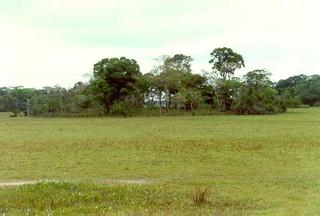|
Fig. 1 Vegetated earthmounds and surrounding grasslands, Pantanal of Mato Grosso, Brazil. HOW TO CALCULATE ONLINE REFERENCE CROP EVAPOTRANSPIRATION BY THE PENMAN-MONTEITH METHOD?
Professor Emeritus of Civil and Environmental Engineering
San Diego State University, San Diego,
California
1. INTRODUCTION
The calculation of reference crop evapotranspiration is a preeminent analytical tool used in
the design of irrigation projects.
The FAO Penman-Monteith method has been recommended as the method of choice for calculating reference crop
evapotranspiration (ETo) (Irrigation and Drainage Paper 56 - Chapter 2, FAO, 1998). In this article
we present an
2. PENMAN-MONTEITH METHOD
The Penman-Monteith method is a modification of the Penman (1948) method.
in which E = total evaporation rate; En = evaporation rate due to net radiation; Ea = evaporation rate due to mass transfer;
Δ = saturation vapor pressure gradient, a function of
air temperature; and γ = psychrometric constant, which may be shown to vary
slightly with temperature.
The mass-transfer
evaporation rate Ea is calculated with an empirical mass-transfer formula
(Ponce, 2014a: In the Penman-Monteith method, the mass-transfer evaporation rate Ea is calculated based on physical principles. The original form of the Penman-Monteith equation, in dimensionally consistent units, is the following (Ponce, 2014b):
in which
The quantity ra-1 is the external conductance, in cm3 of air per cm2 of surface per second (cm/s).
In evaporation rate units, Eq. 2 is expressed as follows:
in which
Equation 4 is the equation of the Penman-Monteith method used in the online calculator presented here.
3. USE OF THE ONLINE CALCULATOR
We run the calculator
ONLINE_PENMAN_MONTEITH with the following input data:
Month [Select one]: Air temperature Ta (C°): Net radiation Qn (cal cm-2 d-1): Relative humidity φ (%): Wind velocity v2
(km d-1): Atmospheric pressure pa (mb): Output from the calculator
is shown below.
The reference crop potential evapotranspiration for the month of April is: 19.32 cm.
ANSWER.

REFERENCES
Food and Agriculture Organization of the United Nations (FAO). 1998.
Crop evapotranspiration: Guidelines for computing crop water requirements,
FAO Irrigation and Drainage Paper 56. https://www.fao.org/3/X0490E/x0490e00.htm#Contents
Penman, H. L. 1948. "Natural Evaporation from Open Water, Bare Soil and Grass," Proceedings of the Royal Society,
London, Vol. 193, 120-145.
Ponce, V. M. 2014a.
Engineering Hydrology: Principles and Practices. https://ponce.sdsu.edu/enghydro/index.html
Ponce, V. M. 2014b.
The Penman-Monteith method. https://ponce.sdsu.edu/penman_monteith_method.html
Ponce, V. M. 2014c.
The psychrometric constant.
https://ponce.sdsu.edu/psychrometric_constant.html
Ponce, V. M. 2020.
ONLINE_PENMAN_MONTEITH. https://ponce.sdsu.edu/onlinepenmanmonteith.php
|
| 240305 |
